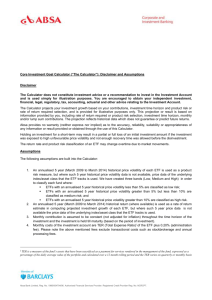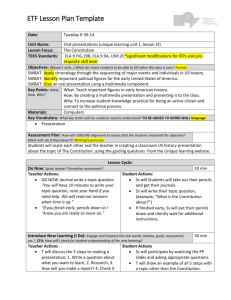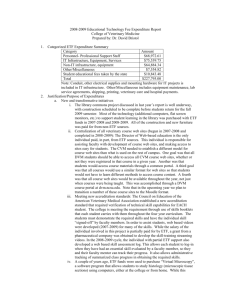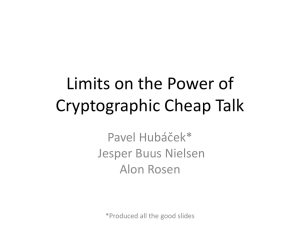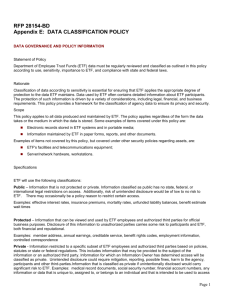Department of Parks, Recreation and Tourism Management
advertisement
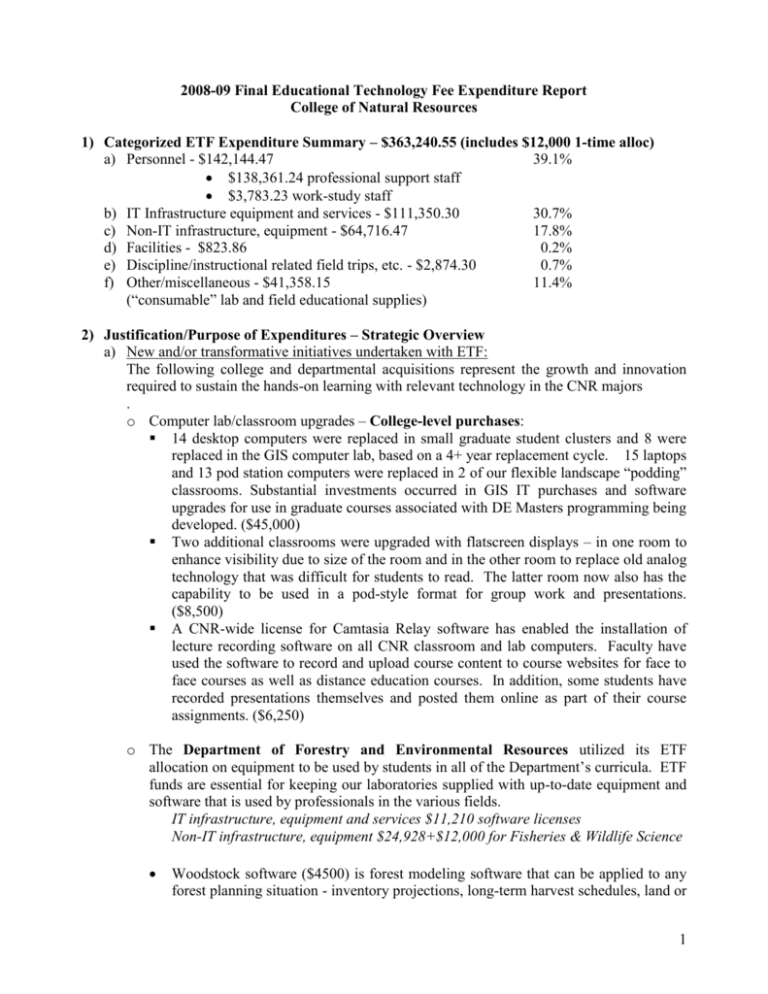
2008-09 Final Educational Technology Fee Expenditure Report College of Natural Resources 1) Categorized ETF Expenditure Summary – $363,240.55 (includes $12,000 1-time alloc) a) Personnel - $142,144.47 39.1% $138,361.24 professional support staff $3,783.23 work-study staff b) IT Infrastructure equipment and services - $111,350.30 30.7% c) Non-IT infrastructure, equipment - $64,716.47 17.8% d) Facilities - $823.86 0.2% e) Discipline/instructional related field trips, etc. - $2,874.30 0.7% f) Other/miscellaneous - $41,358.15 11.4% (“consumable” lab and field educational supplies) 2) Justification/Purpose of Expenditures – Strategic Overview a) New and/or transformative initiatives undertaken with ETF: The following college and departmental acquisitions represent the growth and innovation required to sustain the hands-on learning with relevant technology in the CNR majors . o Computer lab/classroom upgrades – College-level purchases: 14 desktop computers were replaced in small graduate student clusters and 8 were replaced in the GIS computer lab, based on a 4+ year replacement cycle. 15 laptops and 13 pod station computers were replaced in 2 of our flexible landscape “podding” classrooms. Substantial investments occurred in GIS IT purchases and software upgrades for use in graduate courses associated with DE Masters programming being developed. ($45,000) Two additional classrooms were upgraded with flatscreen displays – in one room to enhance visibility due to size of the room and in the other room to replace old analog technology that was difficult for students to read. The latter room now also has the capability to be used in a pod-style format for group work and presentations. ($8,500) A CNR-wide license for Camtasia Relay software has enabled the installation of lecture recording software on all CNR classroom and lab computers. Faculty have used the software to record and upload course content to course websites for face to face courses as well as distance education courses. In addition, some students have recorded presentations themselves and posted them online as part of their course assignments. ($6,250) o The Department of Forestry and Environmental Resources utilized its ETF allocation on equipment to be used by students in all of the Department’s curricula. ETF funds are essential for keeping our laboratories supplied with up-to-date equipment and software that is used by professionals in the various fields. IT infrastructure, equipment and services $11,210 software licenses Non-IT infrastructure, equipment $24,928+$12,000 for Fisheries & Wildlife Science Woodstock software ($4500) is forest modeling software that can be applied to any forest planning situation - inventory projections, long-term harvest schedules, land or 1 silviculture investment queries, biodiversity and wildlife habitat evaluations, compliance certification standards and much more. Students in multiple courses (undergraduate and graduate) can use this software. In June 2009 NC State became one of Remsoft's Educational Partners. Software for use with the Trimble® GeoXT™ handheld ($4,060). This equipment is used in multiple courses, especially those combining GPS and GIS functions. Equipment to Measure Stream Discharge (Water Surveying) ($4,647) Used in watershed hydrology graduate courses. Vertex IV BT & Transponder T3 ($4,620) - Hypsometer makes field operation measuring work faster and more efficient, offering significant time and cost savings, improving the result accuracy and increasing productivity. This equipment is used in forestry courses where students measuring tree heights and plot radius in dense vegetation and rough undergrowth. The Fisheries and Wildlife Sciences Program in FER used ETF funds from its departmental and one-time ($12,000) allocations to purchase: 1 Reconyx Trail Camera, 20 Infrared trail cameras, STELLA software package, 2 Rhino GPS130 units, Plants and signage for the Turner House native plant teaching landscape Reconyx and other infrared cameras are new technology used in increasingly innovative ways in the wildlife management profession. Cameras are used to determine relative habitat use, species presence, and population density estimates based on mark-recapture statistics. Multiple cameras must be operated simultaneously in a field setting to accurately demonstrate the technology to students, in FW 311. STELLA® is a windows friendly object oriented modeling program. It offers a way to dynamically model, visualize, and communicate how complex systems work without programming skills. The program can be used to model wildlife populations, human behavior, and coupled human-natural systems. The software is being used by graduate students to develop conceptual models to visualize their research and will be integrated in FW 411 (Human Dimensions of Wildlife Management) to allow undergraduate students the opportunity to develop models of wildlife management that includes input from stakeholders. o The curricula in the Parks, Recreation & Tourism Management Department are also very hands-on, and require the use of technology in the context of recreation/sport/tourism settings. The classes also tend to be relatively large and making use of classroom technology to enhance discussion has been prevalent in this program. IT infrastructure, equipment: $10,594 Non-IT support: $11,099 The primary focus of our ETF expenditures in 2008-09 was to improve the informal learning environments for our students. A small conference room was converted to a “flyspace” room that students could use to work on group projects. In addition, the graduate learning space was update with new equipment. ($10,594; computers, projector, displays) Additional funds were used to support the outside-of-the-classroom experiential learning that is integral to the PRT programs, including service learning support, field trips to appropriate tourism and leisure industry sites, such as required by PRT 351 – Recreation Consortium Course ($2,000). 2 o The programs in Wood & Paper Science Department have been very successful in producing young professionals well-prepared for challenging technical careers. A large part of this success has been due to the use of intensive hands-on learning. In this approach, students learn basic concepts and principles in the classroom and then move into the laboratory to apply the principles in open-ended, inquiry-guided activities. Of course, hands-on learning in a highly technical program requires extensive laboratory facilities. In turn, these laboratories require extensive funding in order to keep them maintained and supplied. A total of $34,408 was spent from ETF funds last year. These funds were spent in accordance with our annual strategic plan, and they are as shown below. Recurring expenses for supplies and consumables - $10,500 One-Time Allocation from college –$23,908. This amount was spent in two categories: Replacement of Heavily-Used Equipment for Undergraduate Teaching Labs – Balances and viscosity meter for lab - $2427. Improvement of Teaching Labs – Each year, faculty submit requests for equipment purchases that will sustain or improve their teaching laboratories. The remaining $19,610 was spent on such items, including the following: a. Testing equipment, sensors, and software to support a new teaching lab in WPS 309 (Wood Products Processing: Facilities and Infrastructure) b. A new camera controller for a microscope to support wood anatomy labs (WPS 202). c. Replacement of a critical variable-speed drive for the pilot paper machine used for WPS 201, 212, and 472 d. Building on the success of last year’s purchase of an LCD monitor to display simulation and computer control results in the lab for WPS 475 (Process Control Lab), a second monitor was purchased to permit two different simulations to be displayed simultaneously. A similar monitor, mounted on a cart, was purchased for Wood Products classes held in the Hodges Laboratory. The monitor is currently connected to the MTS testing machine that is heavily used by students in WPS 441 (Timber Mechanics), WPS 444 (Wood Composites), and WPS 483 (Senior Project). The cart can be easily wheeled to different locations and so we expect that the monitor will also be used in WPS 491 (CNC Machining) to display machine codes for the router, and in WPS 309 (Wood Products Processing: Facilities and Infrastructure) to display process simulation results. e. To facilitate self-guided instruction and lab demonstration videos, two laboratories were equipped with small LCD monitors on movable carts, enabling “learning in a technology-rich environment” and freeing up the lab instructor from repeated instruction on the same testing techniques. f. A portable laminar flow hood, a tabletop autoclave, and an incubator were purchased to enhance our teaching capabilities in the area of wood bio-deterioration and bioconversion. These topics are now being covered in WPS 301 (Wood Chemistry). b) Actions taken to improve efficiency/return on ETF investments CNR has increased the length of the replacement cycle for computers in the college. To capitalize on campus-wide IT savings, we continue to partner with the Office of Information 3 Technology (OIT) to provide classroom technology at a discount/bulk rate. We have also partnered with Classroom Effectiveness group to leverage donated and ETF funds with University funds to improve acoustics and visibility/sightlines in 2 classrooms. We rely on NCSU Classtech support resources, where appropriate, rather than develop and maintain our own. In addition, the college thoroughly researches purchases in order to maximize the field-ruggedness of our purchased equipment. The departments plan strategically to provide equipment across several courses where possible, and to leverage ETF funds with other funding sources to provide for major capital purchases that will be used in both undergraduate and graduate education. c) Unmet ETF-eligible needs – submitted for 08-09 in requested template on 8/4/2008 For any program that is heavily technology-based – whether IT or lab/field technology – the need for upgrades and repairs to stay even near state-of-the-art is significant. Since the programs in FER and WPS, as well as the GIS program in PRTM, require high levels of technology, a large number of departmental requests for equipment for teaching go unfulfilled. A sufficient level of base support is needed to provide a replacement plan that will address this continual upkeep of equipment such as PDAs, GPS units, laboratory balances, etc., as well as computers. Sufficient base funding also allows better coverage of expendable supplies, allowing more innovation with college one-time allocations to departments. In addition, we have not been able to update the technology in the multi-media classroom to maintain our ability to tape DE lectures and provide teleconferencing capability. As noted previously, two of the CNR departments (FER and PRTM) have started or absorbed 3 new programs with no increase in ETF allocations to provide for the technology needs of those programs. The two programs added in FER (Environmental Technology, and Fisheries and Wildlife) both have high technology demands in a department that is already high in technology needs. The recent increase in our base allocation has help address those needs without penalizing existing programs as much as in the past. d) Assessment of impact of ETF investments on student learning In each of the departments, it is clear that ETF funds are being used to enhance student learning by recreating “near real world” experiences in course activities. Program evaluations by students and alumni have supported the value of having equipment and technology that has helped them bridge the gap between the theoretical and the applied. Review of assessments (course-based and senior interviews) from all of the departments show responses that are very positive; students confirm the value of hands-on learning, as opposed to only classroom learning. They report that such practical education gives them an advantage as they go into the professions that CNR prepares them for. Without ETF funds we would not be able to offer these opportunities and to continue to upgrade and refine the technology that supports these learning experiences. e) Planning and review process Planning for allocation of ETF funds is accomplished by the CNR ETF Committee, composed of mainly teaching faculty representatives from each of the departments, as well as the IT manager and the Academic Dean. After student computer lab replacements and any new college-wide one-time purchases are agreed to by the 4 committee have been covered, remaining funds are divided among the departments to use for capital expenditures. The departments are required to submit proposals for use of the funds for review of appropriateness by the CNR ETF committee, which subsequently identifies the proposals that best fulfill the standards for ETF investment. Each department has a process by which they receive student input. The CNR Student Council reviews the proposed distribution developed by the ETF committee, as well as the final report of ETF expenditures. Distribution within the departments is handled by the faculty, normally by a submission of proposed equipment purchases with justification, which outlines the functional needs for the technology, its scope and scale, as well as the direct benefits to the students. o For example, the Department of Forestry & Environmental Resources polls all faculty members for instructional equipment requests. The ETF funding requests are reviewed for appropriateness and impact through the departmental members on the CNR ETF Committee. Students are informally surveyed through laboratory sessions and student organizations (The Forestry Club and Society of American Foresters). 5 3) Itemized List of Expenditures by Account Code CNR ETF EXPENDITURES FOR FY 2008-09 Account 51219 51270 51410 51450 51811 51813 51821 51830 51891 51990 52101 52300 52400 52590 52600 52650 52821 52823 52824 52850 52870 52872 52873 52874 52875 52900 53144 53210 53230 53272 53510 53550 53600 53923 53925 53928 53929 54437 54511 55200 55223 50000-59999 Description Spa-reg. Salaries Spa Longevity Pay Non-student Reg Wage Student Regular Wage Social Security Federal Health Ins State Retirement Medical Insurance Staff Benefits Other Contr Services Household Sup-janitorial/cln Educational Supply Repair Supplies Other Mtr Veh Suppl Office Supply Data Processing Supplies Other Comp Software <$5,000 PC Software Purch <$5,000 Server Software Purch <$5,000 Other Equip-Voice Comm <$5,000 Other DP Equipment <$5,000 Video Trans Equip <$5,000 LAN Equipment Purch <$5,000 PC & Printer Purch <$5,000 Server Purchases <$5,000 Other Supply Board/nonemp Travel-sub Telephone Service Comm-telecomm Services Telephone Wiring Service Charg Repairs Bldg/gnds Repairs And Maint-oth Eq Freight And Express Svs Agree-lab Svs Svs Agree-waste Remove Svs Agree-lawn & Grnds Service Agreements-other Maint Agrmt - PC Software Insurance-property Edp Equipment PC Software Purch >$5,000 Total Expenditures Total 113,439.31 654.36 192.00 3,591.23 6,753.82 1,579.43 9,367.78 5,918.18 648.36 300.00 13.56 71,978.87 3,332.82 373.30 5,772.70 344.95 2,116.45 15,272.00 5,241.75 3,071.88 305.98 1,179.00 44.18 84,598.16 1,500.00 2,637.26 2,004.00 1,226.62 2,967.00 50.00 60.86 763.00 201.89 280.00 24.67 170.00 2,248.29 163.54 550.00 2,803.35 9,500.00 363,240.55 6
